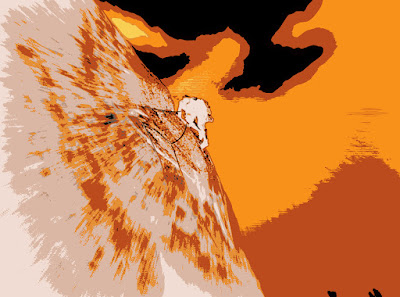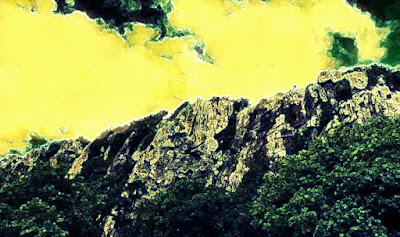I got to know the Tremadog cliffs in 1953 when the Birmingham Cave and Crag Club (of which I was a member) bought Pant Ifan, a traditional Welsh cottage on the plateau above the cliff of that name. We found the cottage on our first trip to the crags when we did a new route by mistake, a common occurrence at Tremadog in those days. I became even keener to go there at weekends after acquiring a Welsh girlfriend called Blodwyn, who worked in the gunpowder works at Penrhyndeudraeth. Her previous Welsh boyfriend had "blown" off the scene owing to an explosion at the factory and I got her on the rebound. The charms of Blodwyn were all very fine but were mainly nocturnal and I had to do something else during the day.
As the cliffs were almost completely untouched new routes became essential to maintain the interest so we set about doing some. Ray Handley tried to do Barbarian one wet day. He took a poor stance with a mediocre peg belay and when my wet P.A.'s slipped I hurtled past Ray, who was pulled off his stance although he managed to hold me. The peg bent completely over until the eye touched the rock and then grated outwards half an inch before mercifully stopping.
After every new route we used to have a celebration; on one occasion we decided to have a drink in every pub in Porthmadog, thirteen there were I think. We just made it back to the hut, where there were some staid sober members seated at a table with a full bottle of whisky on it. I grabbed it and took several gulps. They neglected to tell me that it contained detergent. The bubbles, froth and pain were quite enough until a couple of hours later I also realised that detergent was also a laxative, causing symptoms which are far too disgusting to relate in a magazine as pure as this one.
In the middle fifties I got involved with the Rock and Ice and did new routes with one J. Brown. They used to make early starts because Mortimer the apprentice was the mobile tea-making machine and had the quick method of sucking the condensed milk out of the tin and spitting it into each cup. Everyone knows that I fell off the first ascent of Vector before an admiring throng of 50,000 Joe Brown hero-worshippers.
I was ignominiously lowered to the ground amidst a whirring of cine-cameras, a climax to yet another Brown extravaganza. Pete Crew and I made the second ascent of Tensor after several people had been gripped trying it. I had forgotten my climbing clothes and had to climb in my best suit and unfortunately ripped the trousers badly. This major crime had to be confessed to my wife on getting back to Manchester and this has resulted in a close examination whenever I put on my "bezzies" for signs of abseiling, gardening, resin or chalk. Any signs of these on or in suits cause a mandatory two-week silence.
I had done some sea cliff climbing during my National Service in 1949 when I was an R.A.F. officer, although not a gentleman. I was stationed for a short time at Valley on Anglesey where there were some practise cliffs with a standard set of hard routes. The hardest of them was called "The Wicked" which needed a sling and a special chockstone which was kept in the equipment stores which was signed for and drawn out before an ascent was made. I soloed the route without the chockstone and threw it away; an early example of reducing aid I suppose. Many of my new routes were done with Harry Smith, a prehensile plasterer of enormous strength, who always climbed in a pair of decrepit curly-toed spog boots.
He had a very good collection of firearms and when elated or full of the joys of spring would blast off a few dozen bullets at the nearest target. He taught me how to climb hard and to break through the magic XS barrier. We discovered that we could climb hard at Tremadog all winter and so were very fit for the following summer season. But always after the Alps or even the Himalayas we always went back to our quiet Tremadog crags, where we were the only people on them in those far off days, when I was very young.
Trefor Jones: First Published in the CCJ 1976



